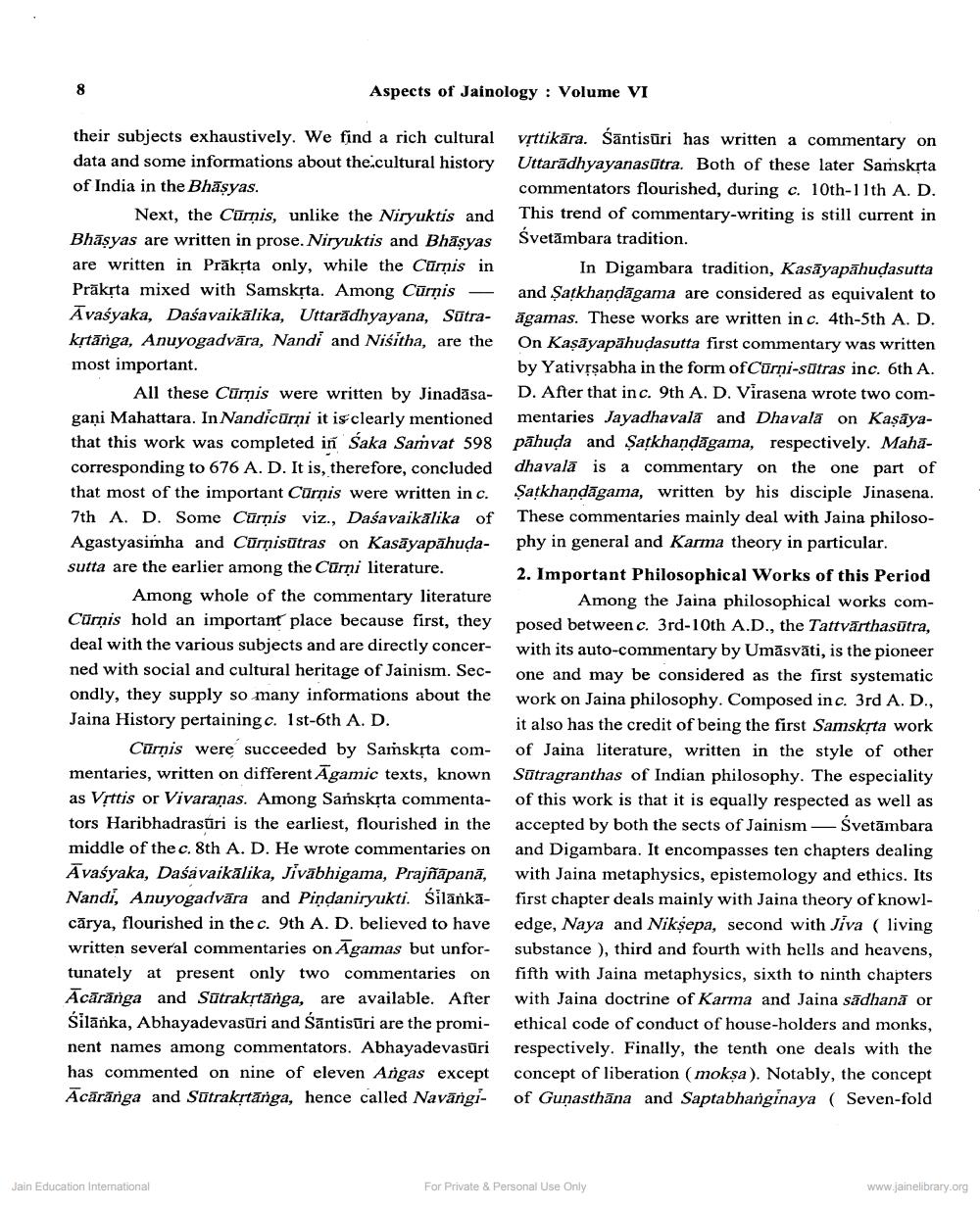________________
Aspects of Jainology : Volume VI
their subjects exhaustively. We find a rich cultural vittikära. Santisūri has written a commentary on data and some informations about the cultural history Uttarādhyayanasūtra. Both of these later Samskrta of India in the Bhāsyas.
commentators flourished, during c. 10th-11th A. D. Next, the Cūrnis, unlike the Niryuktis and This trend of commentary-writing is still current in Bhāşyas are written in prose. Niryuktis and Bhāşyas Svetāmbara tradition. are written in Prāksta only, while the Cūrnis in
In Digambara tradition, Kasāyapāhudasutta Prākta mixed with Samskrta. Among Cūrņis — and Satkhandāgama are considered as equivalent to Āvasyaka, Daśavaikālika, Uttarādhyayana, Sūtra- agamas. These works are written in c. 4th-5th A. D. krtānga, Anuyogadvāra, Nandi and Nisitha, are the On Kaşāyapāhudasutta first commentary was written most important.
by Yativrşabha in the form ofCūrni-sutras inc. 6th A. All these Cūrnis were written by Jinadāsa- D. After that inc. 9th A. D. Virasena wrote two comgani Mahattara. In Nandicūrni it is clearly mentioned mentaries Jayadhavala and Dhavala on Kaşāyathat this work was completed in Saka Samvat 598 pāhuda and Șatkhandāgama, respectively. Mahacorresponding to 676 A. D. It is, therefore, concluded dhavalā is a commentary on the one part of that most of the important Cūrnis were written in c. Satkhandāgama, written by his disciple Jinasena. 7th A. D. Some Cūrnis viz., Daśavaikālika of These commentaries mainly deal with Jaina philosoAgastyasimha and Cūrņisūtras on Kasāyapāhuda- phy in general and Karma theory in particular. sutta are the earlier among the Cūrņi literature.
2. Important Philosophical Works of this period Among whole of the commentary literature
Among the Jaina philosophical works comCürmis hold an important place because first, they posed between c. 3rd-10th A.D., the Tattvärthasūtra, deal with the various subjects and are directly concer- with its auto-commentary by Umāsvāti, is the pioneer ned with social and cultural heritage of Jainism. Sec
one and may be considered as the first systematic ondly, they supply so many informations about the work on Jaina philosophy. Composed in c. 3rd A. D., Jaina History pertaining c. 1st-6th A. D.
it also has the credit of being the first Samskrta work Cūrnis were succeeded by Samskrta com- of Jaina literature, written in the style of other mentaries, written on different Āgamic texts, known Sūtragranthas of Indian philosophy. The especiality as Vittis or Vivaranas. Among Samskrta commenta- of this work is that it is equally respected as well as tors Haribhadrasuri is the earliest, flourished in the accepted by both the sects of Jainism — Svetāmbara middle of the c. 8th A. D. He wrote commentaries on and Digambara. It encompasses ten chapters dealing Avaśyaka, Daśavaikalika, Jivabhigama, Prajñāpanā, with Jaina metaphysics, epistemology and ethics. Its Nandi, Anuyogadvāra and Pindaniryukti. Silanka- first chapter deals mainly with Jaina theory of knowlcārya, flourished in the c. 9th A. D. believed to have edge, Naya and Niksepa, second with Jiva ( living written several commentaries on Agamas but unfor- substance ), third and fourth with hells and heavens, tunately at present only two commentaries on fifth with Jaina metaphysics, sixth to ninth chapters Acāranga and Satrakrtānga, are available. After with Jaina doctrine of Karma and Jaina sādhanā or Silānka, Abhayadevasüri and Santisūri are the promi- ethical code of conduct of house-holders and monks, nent names among commentators. Abhayadevasűri respectively. Finally, the tenth one deals with the has commented on nine of eleven Angas except concept of liberation (mokşa). Notably, the concept Ācārānga and Sūtrakrtānga, hence called Navāngi- of Gunasthāna and Saptabhanginaya ( Seven-fold
Jain Education International
For Private & Personal Use Only
www.jainelibrary.org




